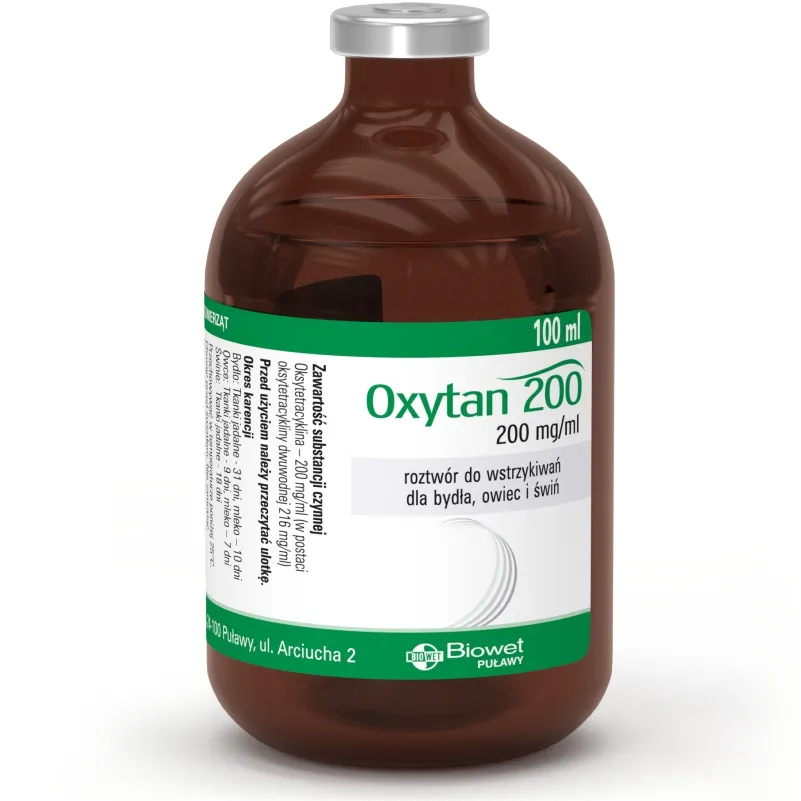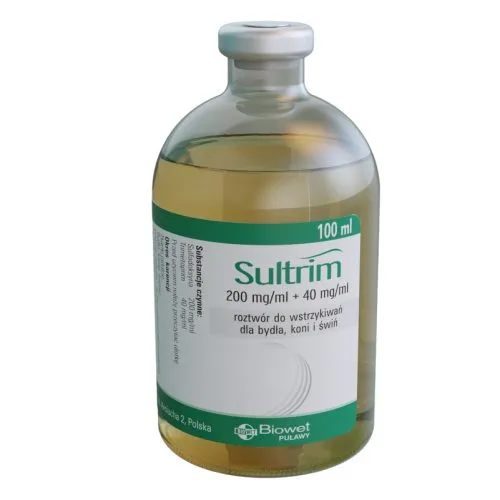Description
200 mg/ml solution for injection for cattle, sheep and swine
Active substance and excipient content
Oxytetracycline – 200 mg/ml (in the form of oxytetracycline dihydrate 216 mg/ml)
Therapeutic indications
The product is intended for use in the treatment of infections induced by microorganisms sensitive to the effect of oxytetracycline, especially in the treatment of:
– atrophic rhinitis induced by Bordetella bronchiseptica, Mannheimia haemolytica andPasteurella multocida,
– conditions of the umbilicus and joints induced by Arcanobacterium pyogenes, E. coli or Staphylococcus aureus,
– mastitis induced by Corynebacterium pyogenes, E. coli, Staphylococcus aureus, Streptococcus agalactiae or Streptococcus uberis,
– endometritis induced by E. coli or Streptococcus pyogenes,
– pasteurellosis and respiratory infections induced by Mannheimia haemolytica and Pasteurella multocida,
– septicaemia induced by Salmonella dublin and Streptococcus pyogenes,
– Erysipeloid of Rosenbach induced by Erysipelothrix rhisiopathiae.
Oxytan 200 can also be used to eliminate enzootic abortion in sheep.
Contraindications
Do not use in the case of hypersensitivity to tetracyclines or any component of the product.
Do not use in horses, dogs and cats.
Do not use in animals with renal and hepatic disorders.
Adverse reactions
Sometimes, temporary reactions in the form of pain and/or swelling might occur at the injection site, but they subside spontaneously.
Any adverse reactions emerged after administration of the product or any observed symptoms not listed in the leaflet (including symptoms reported in humans following exposure to the product) should be reported to the competent veterinarian, Marketing Authorization Holder or the Office for Registration of Medicinal Products, Medical Devices and Biocidal Products. The report form should be downloaded from https://www.urpl.gov.pl (Department of Veterinary Medicinal Products).
Posology for each species, routes and methods of administration
The product should be administered in a single dose, intramuscularly deep into the muscle, in the dose of 20 mg/kg b.w., i.e. 1 ml/10 kg b.w.
The maximum dose administered in one site is as follows:
Cattle: 20 ml
Swine: 10 ml
Sheep: 5 ml
Piglets: one day old 0.2 ml
seven days old 0.3 ml
14 days old 0.4 ml
21 days old 0.5 ml
over 21 days old 1.0 ml/10 kg b.w.
Recommendations for proper administration
In order to ensure that administration is appropriate, the bodyweights of the treated animals should be estimated as accurately as possible. General aseptic rules should be observed during the use of the product. The product should not be diluted before use.
Withdrawal period
Cattle: Edible tissues – 31 days
Milk – 10 days
Sheep: Edible tissues – 9 days
Milk – 7 days
Swine: Edible tissues – 18 days
Special precautions for storage
Keep out of the reach and sight of children.
Store at a temperature below 25oC. Protect from light. Do not freeze.
Use within 28 days after first opening of the immediate packaging.
Do not use the veterinary medicinal product after the expiry date stated on the label and the box.
The durability period after the first opening of the immediate container: 28 days.
Special warnings
Special precautions for use in animals:
Pathogen sensitivity to oxytetracycline might be varied. Therefore, use of the product should be based on tests of drug resistance of microorganisms isolated in the given case. If this is impossible, the treatment should be performed on the basis of available local epidemiological information, including official regulations and guidelines.
Improper use of the product might lead to an increased number of oxytetracycline-resistant bacteria and to reduced efficiency of treatment using other tetracyclines as a result of cross-resistance.
In the case of conditions with concomitant impairment of renal functions, the half-life of oxytetracycline is significantly longer and, in the case of multiple administrations, it may accumulate in the body.
If repeated administration of the drug is required, it should not be injected in the area of the body used for the previous injection.
Special precautions for persons administering the veterinary medicinal product to animals:
People with diagnosed hypersensitivity to tetracyclines should avoid contact with the product. During the use of the veterinary medicinal product, caution should be taken to avoid accidental self-injection and contact with skin and mucosa.
In the case of accidental self-injection, immediately seek medical advice and show the package leaflet or the package to the physician.
If the product comes into contact with an eye, wash the eye with plenty of water and seek medical advice.
If, as a result of the contact with the product, such symptoms as a rash occur, you should seek immediate medical advice and show the package leaflet or the leaflet to the physician. Swelling of the face, lips or eyes as well as breathing difficulties require immediate medical help.
Pregnancy:
Do not use in pregnancy.
Use of oxytetracycline during bone formation might cause their developmental disorders. Administration of oxytetracycline at the end of pregnancy might cause teeth enamel discoloration.
Lactation:
The product can be used in lactation.
Interactions with other medicinal products or other forms of interactions:
Tetracyclines chelate with divalent metal cations. Therefore, combining them with mineral products and infusion fluids is not recommended.
Overdose (symptoms, procedures concerning immediate help and antidotes):
Exceeding the recommended dose might induce hepatotoxic and nephrotoxic effect of the drug.
Specific antidote does not exist.
In the case of overdose, discontinue administration of the drug and apply symptomatic treatment.
Pharmaceutical incompatibilities:
Unknown
Special precautions for the disposal of unused veterinary medicinal product or waste materials derived from the use of such products
Medicines should not be disposed of via wastewater or household waste.
Ask your veterinary surgeon how to dispose of medicines no longer required. These measures should help to protect the environment.
Shelf life
Shelf life for a medicinal veterinary product packed for sale: 2 years.
Available containers
100 ml
Other information
For more information about this veterinary medicinal product, contact the Marketing Authorization Holder.
For animal treatment only.
Subject to medical prescription – prescription drug.
To be administered under veterinary supervision.
Name and address of the manufacturer responsible for batch release:
Biowet Puławy Sp. z o.o.
Arciucha 2, 24-100 Puławy
2015-12-01 decision of urpl (Office for Registration of Medicinal Procuts, Medicla Devices and Biocides)
2015-12-01 SPC
31.08.2017 r.






